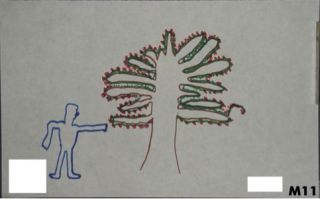
Health
Healing Our Achilles Heel: Art Therapy Research in Prison
The effectiveness of art therapy in prison—the pilot study
Posted December 17, 2013

"Person" Picking An Apple from a Tree--inmate drawing
The previous post, Art Therapy with a Recalcitrant Sociopath resulted in a number of readers’ comments–while a few were vituperative, most were supportive—that raised a couple of valid concerns. [As noted, I did take umbrage to one of the more insulting commenters, Anonymous’, designation that as an art therapist, I must be an uneducated, unprofessional moron**. To be clear, I am a professional, educated moron]. Specifically, many of the ‘discussion' comments could be distilled down to a single question:
Where is the evidence that supports the benefits of art therapy?
One of the more reasonable commenters, Thomas Shortliffe—a respected art therapy colleague from Montreal Canada- admitted in a response to one of Anonymous’ attacks (may I call you Annie?) “In fairness, the [lack of] hard scientific evidence in support of art therapy is it's Achilles’ tendon.” I concur.
One of our field’s challenges has been its historical lack of robust research. Why this is has been debated within many forums. While art therapy has historically focused on case studies, anecdotal references and qualitative explorations, there had been little empirical, evidence-based support for the benefits of art therapy. What there was did not seem nearly as sexy as the in-depth, narrative explorations that emerged in the publications; and no wonder—artistic expression and creative therapeutic interventions lent itself to good, informative and inspiring story-telling [I must confess—I held tightly onto this concept as well].
However, this continues to evolve, and many clinicians and educators in our field recognize that there is a place for both—robust, generalizable empirical research and in-depth, leave-no-stone-unturned qualitative exploration—to underscore the benefits of visual arts and art therapy in increasingly widening mental health, neuroscientific and health-focused areas. They continue to develop strong research agendas, and the American Art Therapy Association, recognizing its importance, has made it a priority and formed the new Research Foundation Task Force.
Although originally a qualitative researcher, I have since had my own epiphany, resulting in a change of methodological heart. As a result, from 2003-2009 I conducted a number of outcome research projects combining quantitative exploration and illustrative case vignettes to determine if indeed art therapy in prison was effective.
You see, for years, while we have been touting theories on why art therapy might benefit prison inmates, supported through the types of vignettes described above, we never stopped to examine whether this was actually so. Therefore, with oversight by Florida State University’s Institutional Review Board (IRB) the Florida Department of Corrections, and support through grants, we conducted four stringent research studies. These studies have since been disseminated in various articles in peer-reviewed journals, book chapters and national and international presentations—within and between several professional areas.
Granted, these weren’t the first studies conducted in prison on the effectiveness of art. As mentioned in the previous post Art Behind Bars, “One study revealed the act of art making can decrease the number of disciplinary reports written on inmates who participated in an arts program (Brewster, 1983), and the California Department of Corrections revealed that recidivism decreased for those who participated in the state’s Arts In Corrections program.” However, these studies are quite dated and nothing on the benefits of art therapy in prison was ever really conducted—yet.
Therefore, I’ll shift away from the previous narratives and will spend the next several posts presenting these studies.
The pilot begins the lengthy journey

Pre-test PPAT drawing
Like any new research agenda, this one started with a simple pilot study, conducted in 2003. Because it was the first foray, it was developed as a quasi-experimental, single-group pre/post-test design to address the simple hypothesis that inmates receiving art therapy services would demonstrate marked change (Gussak, 2004).
The researcher and several art therapy interns conducted art therapy group sessions in one men’s prison. This modest pilot study was conducted over 4 weeks, two sessions a week, one hour a session. There were 44 male inmates participating, divided up into groups no larger than 8 members.
The results were calculated using simple t-tests with SPSS. The scores of the FEATS drawings (which were double blind-reviewed by three art therapists not associated with the sessions) and the Likert-scale survey completed by the mental health and correctional staff revealed significant decrease in depression, and an increase in energy, socialization and problem solving. As well, it was verified through observations by the correctional staff and confirmed by the surveys that the inmates who participated in the program followed directions better and were less impulsive.

Posttest PPAT drawing
Hence these results supported the hypothesis—that those inmates who participated in art therapy sessions demonstrated a measureable change.
[To review the entire study, including methods, art therapy directives and statistical results, you may find this article, published in The Arts in Psychotherapy, here. A version in word document is also available on the website www.arttherapyinprison.com.]
While a modest beginning, the warden and the Director of Mental Health for the Florida Department of Corrections thought the results impressive enough to develop a larger program, one that solidified the art therapy intern presence in the prison system.
Oh, also, I found this approach just as sexy…
Coming up…
The next post will present the follow-up study, in which steps were taken to make our research in prison that much more stringent and robust, including adding a control group and a new measurement tool.

Pre/Post PPAT Drawing
** To be fair, Anonymous apologized for the insult following my response.
References
Brewster, L.G. (1983). An evaluation of the arts-in-corrections program of the California Department of Corrections. San Jose, CA: San Jose State University
Gussak, D. (2004). Art therapy with prison inmates: A pilot study. The Arts In Psychotherapy, 31(4), 245-259



